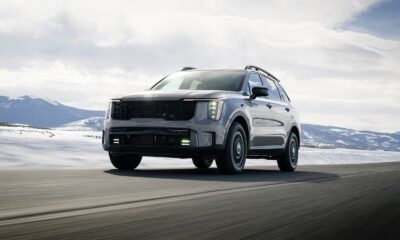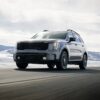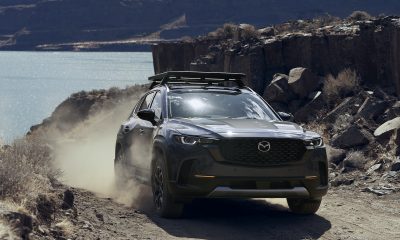Car Reviews
KIA’S EV6 GT: ELEGANCE ELECTRIFIED
KIA’S EV6 GT:
ELEGANCE ELECTRIFIED
It felt like Chewbacca was following the command, “Take us to warp speed, Chewie.”
With a quick mash of the right pedal, from within the Kia EV6 GT the outside scenery began to blur. Inside, bodies smacked into well-bolstered vegan leather seats while a configurable sound effect mimicked a bullet train leaving the station.
In just 3.2 seconds, front and rear motors delivered 576 hp and 446 pound-feet of torque through all four wheels as the car rocketed past 60 mph faster than Robin might utter, “Holy hyper speed, Batman! We are outrunning our shadows!”
At that point it seemed wise to employ the GT’s 15.0-inch (front) and 14.2-inch (rear) four-piston calipers instead of inventing an explanation for one’s behavior that would be plausible to the local constabulary. “We just had to see if Kia’s $62,865 compact SUV is faster than a Ferrari Roma or Lamborghini Huracan Evo Spyder costing four times as much.” Rehearsing this to myself, it didn’t sound like it would play well in a courtroom.
It is faster than both Italians, at least in an eighth of a mile. The 612-hp Roma tops out at 199 mph, and the 602-hp Evo at 202. Kia says the EV6 GT has a top speed of 161, but we could not think of any place within 100 miles where we could safely evaluate that.
That distance was a critical factor because, although Kia upgraded the suspension and brakes of the GT model, it did not increase the capacity of the 77.4-kWh battery, which is good for 274 to 282 miles in a regular, dual-motor EV6 and 310 miles in the single-motor version. The GT comes with an estimated range of 206 miles, but driving on Texas highways – where there are no slow lanes ‘til you get out of Texas – it will not do that.
Not that range anxiety ever darkened our week with a machine that informs us that the day of the EV will bring spectacular cars. Kia generously sent along a charger, which we plugged into a regular 110-volt outlet every night. That was good enough to start with a 70% charge every morning. Despite questionable driving, we never saw it drop below 50%.
Why only 70%? What a perceptive question. Charging a battery is not linear, like filling a gas tank, which requires pumping at a constant rate until it is full. Reaching a greater charge requires increasingly more energy. The charger also could have plugged into a 220 outlet, but we did not have a spare one in our garage.
Revolution in slow motion
Why are Americans adopting EVs at about a third of the rate of consumers in Europe and Asia? This is happening more slowly than manufacturers forecast, and I will eschew making predictions about when that might change.
Watching the torrent of coverage and commentary that flows past my desk, I will say that broken crystal balls filled with hyperbole litter the road to seeing into the automotive future.
The best guess here is that Americans’ EV reluctance is a product of three dynamic forces:
- Prices are too high. It makes sense that in the development stage manufacturers rightfully should focus on high-income early adapters. This is a cash-burning process, and companies should gather what dollars they can on the trail.
- Those of us who live in fly-over America clearly understand that the paucity of charging stations makes road trips unfeasible. Beautiful Bride and I just finished our annual honeymoon to the beach. We eschew the interstates in favor of rolling forests free of 18-wheelers. We did not see one charging station between here and the Bolivar Peninsula.
- Gas-hogging pickups and SUVs continue to enrapture American buyers. During Covid, the manufacturers observed dealers jacking up prices for these and decided the smart play was to follow suit. Americans are paying those prices and automakers are using the bloated profits to finance billions of dollars for EV and battery factories.
The end of that line lurks in the proximal distance. Manufacturers are now facing tens of billions of dollars in fines for failing to meet fuel-efficiency standards. Unless the Republicans recapture the White House, a change of strategy might be in order.
Here are the trend lines I am seeing:
- Every week brings more announcements of new EV models. Consumer Reports counted three dozen new ones that will be on sale within a year. Only a handful will sell in the $25,000 to $35,000 range.
- Battery technology is quickly evolving. Lithium, with the least molar mass of any element, is superior for energy density and battery weight, but sodium, graphite, and aluminum are much more abundant, cleaner to mine, and much less expensive. Scientists have made significant advances in battery technology in just the past year. Toyota and Porsche this week announced that they are nearing production on solid-state batteries that can increase ranges to 600-800 miles. Nissan said it expects to have solid-state battery vehicles on the road by 2028.
- Though Americans are not ready for EVs, hybrid vehicles have seen a 20% increase in sales this year. Now in its third decade, this mature technology is more dependable than internal combustion-only powertrains and allows manufacturers to reach fuel standards. Blonde Bride and I recently took delivery of a lovely plug-in hybrid Ford Escape, which runs for about 32 miles on a battery before the gas-electric hybrid starts working at about 40 mpg. In the first 100 miles, we used ¼ gallon of gas. It plugs into the wall.
We still reside in the backwaters of the nation’s slowly evolving charger network and high-speed chargers – needed for road trips with EVs – are sparse. The only one within the city limits serves only Teslas. The good news: This week Kia and Hyundai last week joined Ford, GM, and Nissan in adopting Tesla’s charging standard. Soon, every EV will come with adapters suitable for both Tesla’s network and other networks, coming to a Walmart near you.
Pleasant change
Here is the good news. When EVs do arrive in critical mass, they are likely to be much better than the vehicles they replace. Case in point is the Kia EV6. With its impressive warranty, safety features, driver-assist technology, stunning exterior design and refined cabin, the EV6 dares to challenge the status quo with both style and substance.
Our tester lists for $63,000, which is about $7,000 less than a comparably equipped Tesla Model Y, the chief competitor to the EV6 and its corporate cousin, the Hyundai Ioniq 5. A base EV6 Wind starts at $48,700, within pennies of a base Model Y after Tesla announced a price cut Friday.
For our money, the EV6 is the better buy because it rides significantly more smoothly and quietly than the Tesla. The Tesla does have usable frunk space and more cargo space in the rear and comes with an optional third row, so it might be better for a family.
The EV6, on the other hand, is a driver-focused car, with two curved display screens. Unlike the Tesla, in which a single touch screen provides access to all controls, the EV6 also has buttons and knobs. Call me old-fashioned, but I like tuning and volume knobs, as well as a stalk for the windshield wipers.
Here, then, is where the EV6 excels:
Exterior Design
The EV6’s exterior is captivating, an exquisite blend of form and function. Aerodynamic contours and sleek lines command attention, while the coupe-like silhouette adds a touch of sportiness to its electric persona. The LED lighting signature dances across the road, leaving a trail of envy in its wake. Kia’s designers have masterfully crafted a vehicle that turns heads and sparks(!) conversations at every corner.
Safety
Safety takes center stage in the EV6, as Kia leaves no stone unturned in protecting its occupants. Equipped with an array of advanced driver-assist technologies, including blind-spot monitoring, lane-keeping assist and forward collision avoidance.
An augmented reality heads-up display projects three-dimensional images on the windshield, providing continuous monitoring of the highway and tracking data such as speed limit, current speed, and dynamic cruise control settings. Kia’s lane-centering system is as good as Mercedes.
Driver Assist Technology
The Kia’s driver-assist technology is a symphony of innovation and convenience. From the seamless integration of adaptive cruise control to the intuitive parking assist, the EV6 aims to simplify the driving experience. Its ability to effortlessly adapt to changing traffic conditions and anticipate your every move makes it a worthy companion on both long journeys and bustling city streets.
Engage the turn signal on the highway, and it will change lanes when it is safe to do so, and turn off the turn signal, which is important to us grandpas.
With EV6, driving becomes an art and you – Dear Reader – are the maestro.
Comfort and Sophistication
The cabin is a sanctuary of comfort and sophistication. Refined materials, plush seating, and careful craftsmanship elevate the driving experience to new heights. The spaciousness is a breath of fresh air, ensuring that both driver and passengers can relish the journey. With innovative technology seamlessly integrated into the interior, the EV6’s cabin becomes a sanctuary where comfort and digital sophistication converge.
The EV6 features a large, high-resolution infotainment display that serves as the central hub for controlling various vehicle functions. The touchscreen interface provides access to features such as navigation, media playback, smartphone integration (e.g., Apple CarPlay and Android Auto), and vehicle settings. The system is user-friendly and responsive, offering a modern and immersive digital experience.
Adjacent to the infotainment display, the EV6 incorporates a digital instrument cluster behind the steering wheel. This customizable display provides essential driving information, including speed, range, battery status, and navigation directions. Drivers can personalize the layout and content of the instrument cluster to suit their preferences and easily access relevant data while keeping their focus on the road.
Turn on a turn signal, and a camera view of the adjoining lane pops up in the cluster. Tesla offers this, but the camera view shows up at the bottom of the center screen, which is not where one’s eyes need to be when making a lane change.
Sound System
Kia partnered with high-end audio brand Meridian to deliver an immersive sound experience in the EV6. The system incorporates strategically placed speakers throughout the cabin, creating a precise and enveloping audio environment.
Connectivity and OTA Updates: The EV6 supports connectivity features, enabling seamless integration with smartphones and other devices. Occupants can access their favorite apps, stream music, and make hands-free calls using the infotainment system. Additionally, the EV6 offers Over-The-Air (OTA) software updates, allowing for remote updates and enhancements to the vehicle’s software.
The EV6 quickly and seamlessly integrated with our phones.
Warranty
Kia’s commitment to customer satisfaction is well represented by the EV6’s generous warranty. With a 10-year/100,000-mile warranty for the powertrain and a 5-year/60,000-mile warranty for the vehicle, Kia demonstrates confidence in the longevity and reliability of its electric masterpiece. It is a comforting embrace for those venturing into the uncharted territory of electric vehicles.
Bottom line:
After doing this for three decades, the question I most often hear is, “What’s the best car you’ve driven?” Kia’s EV6 is high on that list.










































